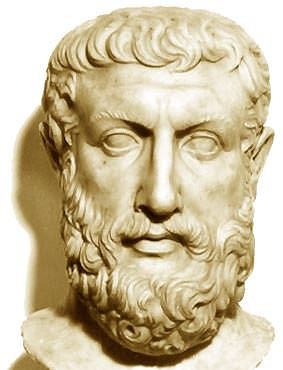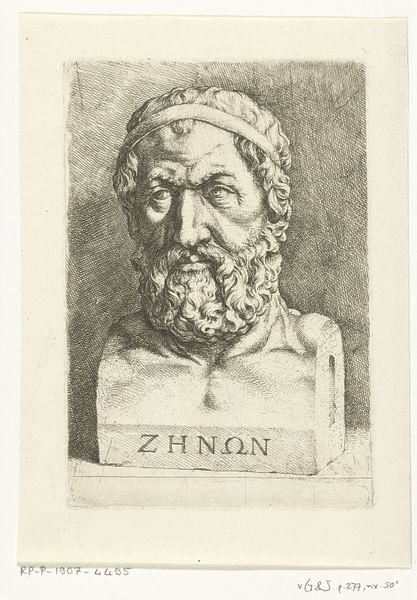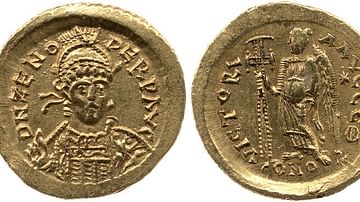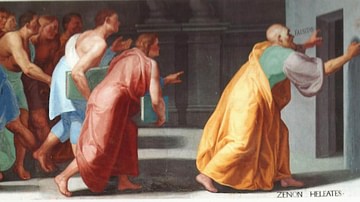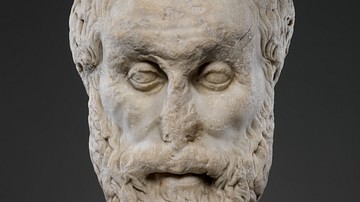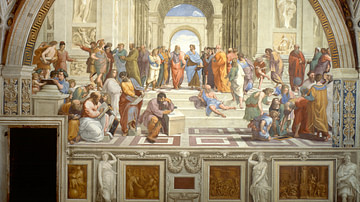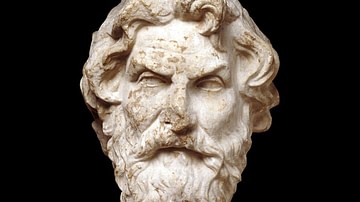The creation of the art of dialectic is credited to Zeno of Elea, the philosophical champion of Parmenides’ claim that the essence of reality is One and unchanging. Zeno was Parmenides’ student and protégé and, in defending and defining his mentor’s vision, Zeno wrote a series of philosophical paradoxes that established dialectic as the method of philosophical inquiry still used today.
Zeno (l. c. 465 BCE) is regularly identified as Zeno of Elea which could mean he was from the colony of Elea in southern Italy, as Parmenides (l. c. 485 BCE) was, or could mean he was of the Eleatic School Parmenides established. Parmenides taught a strict version of philosophical monism, the belief that the world is made up of a single, indestructible, indivisible, essence and what people perceive as being Many is actually One.
Although Parmenides was well respected by his students, his claims regarding the nature of existence were not generally accepted by others as they were thought to contradict basic common sense. Parmenides’ claim that what people perceive as different is in essence the same seemed to be refuted by everyday reality. Zeno set out to prove, mathematically and logically, that Parmenides’ view was correct.
According to Aristotle (l. 384-322 BCE), Zeno wrote 40 paradoxes proving the monist claim by showing how one’s senses could not be relied upon to apprehend true reality. The paradoxes initiated the kind of philosophical discourse which has come to known as dialectic.
Parmenides’ Claim
Parmenides’ philosophy is preserved by later philosophers, most notably Plato (l. 428/427 - 348/347 BCE) in his dialogue of the Parmenides which also presents Zeno’s defense of his master. Parmenides’ first-hand account of his claims is also still extant, however, in the form of fragments of a long poem written by him, and addressed to Zeno, from c. 475 BCE. The poem was divided into three sections: the Prologue, the Way of Truth, and the Way of Opinion, each one differentiating what Parmenides called “the way which is” from “the way which is not” or the path toward truth and the way of opinion and illusion.
To Parmenides, reality could not be understood by relying upon sense perceptions; one had to depend on reason and logic. Even when one’s conclusions contradicted empirical observation, they should still be recognized as true because sense perception could only lead one to form opinions about the world and prevented one from seeing reality as it truly is. Scholar Forrest E. Baird explains:
According to Parmenides, there are two ways of inquiry. The first asserts that whatever is (i.e. being), "is and cannot not-be". This is the path of truth that leads us to see that being is one and cannot be created, destroyed, or changed. If any of these alterations in being were possible, being would no longer be what "is" and would become what "is not" – but, by definition, there is no "is not" from which being could arise or into which being could change. Being must be one seamless, unchanging whole. The other path of inquiry, the path of opinion, which claims that something arises from not-being, is not only impossible, it is unthinkable. (22)
The Way of Opinion, to Parmenides, was impossible and unthinkable because it claimed that "what is" not only came from "what is not" but that "what is" took many forms, was subject to change, and could finally "not be". This is logically impossible because nothing can come from nothing, and that which exists cannot return to a state it never came from in the first place. Humans suffer and worry over change and death because they have allowed themselves to become trapped by sense perception in the Way of Opinion which can never lead one to an apprehension of true reality because it denies the fundamental nature of reality.
True reality has always existed, since it could not have come from nothing, and will always exist, since it cannot return to a state it never arose from, and is of one single substance. The plurality one insists on as "reality" – that there are many different forms of reality such as people, dogs, trees, mountains, waterfalls, and such – is an illusion produced by the senses. The outward manifestation of reality one perceives as Many is only the senses misinterpreting actual reality. The underlying essence of reality is exactly the same in all of these things and so there is no fundamental difference between the tree and the person and the dog – their reality-essence is the same – they only seem different to those trapped in the Way of Opinion. Reality is stable, unchanging, and indivisible in Parmenides’ vision and its essence is motionless. Parmenides writes:
For there is not, nor will there be, anything other than what is since indeed Destiny has fettered it to remain whole and immovable. Therefore, those things which mortals have established, believing them to be true, will be mere names: "coming into being and passing away", "being and not-being", "change of place and alteration of bright color". (fragment 6.15, Robinson, 116)
Parmenides’ use of the term "destiny" above should not be understood as "fate", as something dictated by some power or previous event, but simply "how things are" or "how things work", the natural operation of reality-as-reality. Scholar John Mansley Robinson explains:
We can see immediately why it [Being] would have to be motionless. In order for a thing to move, it must have a place to move to. But clearly there is no place into which being could move. For, as Parmenides has already explained, "all is full of what is" (6.11). There is nothing outside of what is, capable of containing it; for what could be outside of it? Only nothingness, and the existence of nothingness is inconceivable. (116)
Recognizing that motion equaled change and change argued against Parmenides’ vision, Zeno would focus his defense on proving that motion was an illusion.
Zeno’s Paradoxes
Parmenides explained his views in his poem and, apparently, in lectures but, to many in his audience, what he was saying contradicted common sense. A person, after all, was not a dog or a tree and there was no way one could prove that they were by an appeal to a Way of Truth which seemed to depend on one’s acceptance of it on faith for it to then be convincing.
Parmenides was not arguing for a faith-based doctrine, however, but for a logical approach to perceiving reality. If one claimed that the person, dog, and tree were three separate entities, one was claiming all three emerged from separate points of origin. Since all three participated in reality, however, all three must have the same point of origin as everything else participating in the same and, therefore, be of the same essential essence. Being might manifest in different forms, but its essence was always the same and undifferentiated. No one ever aged or died, their outward form might appear to have changed, but not their essence.
These claims were still met with resistance which prompted Zeno to create his paradoxes proving that sense perception could not be trusted, reality was One, and even the most basic and seemingly self-evident "facts" of life were illusions and logical impossibilities. Aristotle claims Zeno wrote 40 paradoxes of which less than ten exist today. The most famous of these, all four arguing against the possibility of motion, are:
The Race Course argues that in order for someone to move from Point A to Point Z, one must first get to the halfway point between A and Z. However, in order to reach that halfway point, one must get to the halfway point between Point A and that halfway point, and to reach that spot, one must travel halfway again. Since there will always be a space, even an infinitesimal one, between one point and another, and since one must always move halfway before one may reach one's destination, motion is impossible. Our senses, which tell us that motion is possible, must then be flawed and should not be trusted to apprehend truth.
The Achilles argument claims that the swiftest runner will never overtake the slowest who begins the race first with a significant head start, "inasmuch as, reckoning from any given instant, the pursuer, before he can catch the pursued, must reach the point from which the pursued started at that instant, and so the slower will always be some distance in advance of the swifter" (Baird, 28). In other words, because the slower runner (usually depicted as a tortoise while the swifter is known as 'Achilles') is in advance of the swifter, the swifter must first arrive at that point where the slower runner began and, as the slower will always be ahead of the swifter by virtue of having started earlier, the swifter must always be in pursuit of the slower without ever having hope of catching him. What people perceive as a "race" in which one person overtakes and outdistances another, must therefore be an illusion of the senses because, logically, such an event is impossible.
The Arrow shows how an arrow in flight cannot possibly move as "everything is at rest when it is in a place equal to itself, and if the moving object is always in the present [and therefore in a place equal to itself] then the moving arrow is motionless" (Robinson, 134). Since all anyone lives in, at any moment, is the present and since the arrow is motionless at any given moment in its flight, the arrow cannot actually be moving. One who watches an arrow in flight and claims it is moving is misinterpreting "what is" – that the arrow is motionless moment-to-moment – for "what seems" – that the arrow is in flight.
The Stadium also argues against the possibility of motion by asking an audience to imagine a stadium in which three rows of runners, A, B, C, move in a line in opposite directions with the end of their lines at different points. When they begin to run back and forth, before A reaches the point of B returning, it must reach a halfway point, as does C with B and B with the other two, and before reaching that point, must again reach a halfway point so, like the Race Course, actual motion is impossible because each halfway point has a halfway point and so, as Aristotle notes, it is "impossible to move because what moves must reach the halfway point earlier than the end" and there is no "end" to the divisibility of halfway points (Physics, 6. 9, 239b, 11-13). It may appear to someone in the stadium that they are watching athletes run back and forth, but there is no such thing as motion and so what is being claimed as a reality is actually an illusion.
The aim of each paradox in proving motion impossible is to show how, if one can be mistaken about the true nature of motion, one can be mistaken about one’s apprehension of reality as a whole. Further, in logically proving the impossibility of motion, the concept of mutability and change is challenged, since motion includes that concept – one has moved from one place to another – and if motion does not exist, change does not exist, and so Parmenides’ vision is correct that Being is immovable, unchangeable, and indivisible. All that people perceive as motion or change is an illusion of sense perception; the essence of one’s reality remains unchanged.
The Creation of Dialectic
The paradoxes logically proved the impossibility of motion, but this did not necessarily lead to any greater acceptance of Parmenides’ philosophy. Even in Plato’s dialogue of the Parmenides, the paradoxes are criticized, and Aristotle also struggled with their relevance and practicality. The paradoxes were not regarded as simple word puzzles, however, but engaged Zeno’s audience fully and gave rise to analysis and discussion of a question, known as dialectic, which allowed for dispassionate, intellectual inquiry into a matter without the distraction of opinion. Robinson defines the art and its application:
Dialectic involves two people: a questioner and an answerer. The questioner invites the answerer to take up a position which he thinks he can defend, and proceeds by a series of well-placed questions to drive him from it. He does this by getting the answerer to agree to a series of further propositions which, taken together, imply the contradictory of the original thesis. (Robinson, 137)
To use the Race Course as an example, the questioner would invite the answerer to defend the reality of motion. The questioner, using the paradox as the baseline understanding but without necessarily explicitly referencing it, would lead the answerer to agree to propositions relating to it and then close the argument with what is known as the method of elenchus (“refutation”) made famous by Plato’s dialogues. The Race Course would serve as an underlying kind of warrant which validates the questioner’s claim and argument. Without the underlying warrant in an argument, all one has to go on is opinion.
Conclusion
Zeno’s paradoxes were the precursors to Plato’s famous works in that they sought to establish a logical, rational foundation for an argument that removed opinion from the table. An interlocutor of Zeno’s would be forced to confront the claims made by the paradoxes on those paradoxes’ own grounds. One might begin such an argument insisting it was common sense that motion and change exist but, through dialectic, one would be forced to question that claim and, if honest, admit that perhaps one’s beliefs were false or, at least, not as self-evidently true as one had believed.
The influence of Zeno’s paradoxes on Plato’s work is apparent in his careful construction of the arguments he places in the mouth of Socrates who consistently draws an interlocutor into agreement on a series of propositions before showing how inconsistent those are with the person’s stated claim at the beginning of the discussion. Plato's Dialogues are virtual handbooks on the art of dialectic. In Republic, dialectic is used to find out what justice is by first defining what it is not; in Euthyphro, it is used to define piety; in the Ion, the question of 'What is Art' is considered; and in Meno, the concept of virtue is clarified using the same method.
Zeno seems to have only intended to form a rational defense for Parmenides’ claim but wound up establishing a completely new method of inquiry and the means by which one could logically come to conclusions in an argument without slipping into a war of words of opinion. Having a rational basis set the guidelines for inquiry and discussion, removed opinion, and left the philosophical field open for pursuit of the Way of Truth. Whether he intended to, Zeno handed down to Plato the means by which the latter would lay the groundwork for Western Philosophy.

